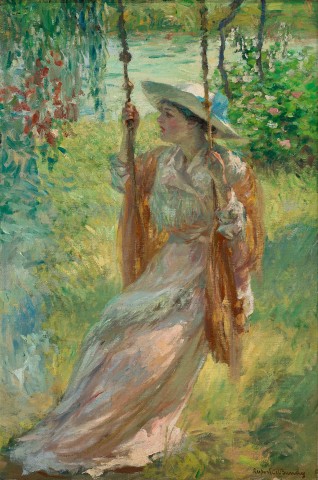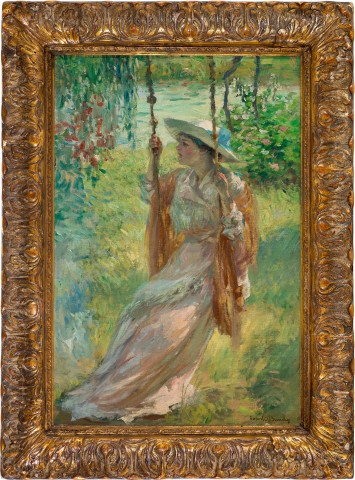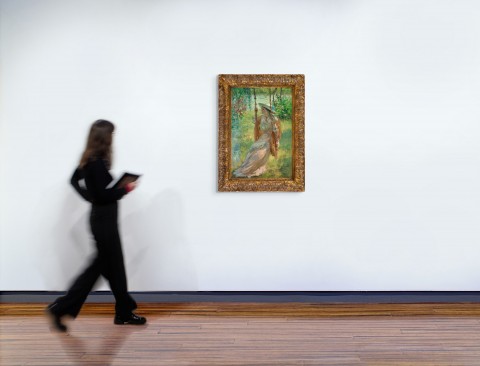THE SWING, c.1913
RUPERT BUNNY
oil on canvas
80.5 x 54.0 cm
signed lower right: Rupert C W Bunny
Private collection, Chile
Philip Bacon Galleries, Brisbane
D. Johnston, Perth
Deutscher~Menzies, Melbourne, 22 November 1998, lot 302
Private collection, Melbourne
Rupert Bunny: Artist in Paris, Art Gallery of New South Wales, Sydney, 21 November 2009 – 21 February 2010; and touring to The Ian Potter Centre: NGV Australia, Melbourne, 26 March – 4 July 2010, and Art Gallery of South Australia, Adelaide, 23 July – 4 October 2010, cat. 37 (label attached verso)
$4 million art auction', Australian Jewish News, Melbourne, 13 November 1998, p. 6 (illus.)
Maslen, G., 'Art-sale upswing marks challenge by newcomer', The Age, 23 November 1998, p. 8 (illus.)
Edwards, D., Rupert Bunny: Artist in Paris, Art Gallery of New South Wales, Sydney, 2009, pp. 82, 98 (illus.), 205
Thomas, D., The Life and Art of Rupert Bunny, A Catalogue Raisonné in Two Volumes, Thames & Hudson, Melbourne, 2017, cat. O375, vol. I, pp. 12 (illus.), 52, vol. II, p. 51
Lot 8 Rupert Bunny (1).jpg
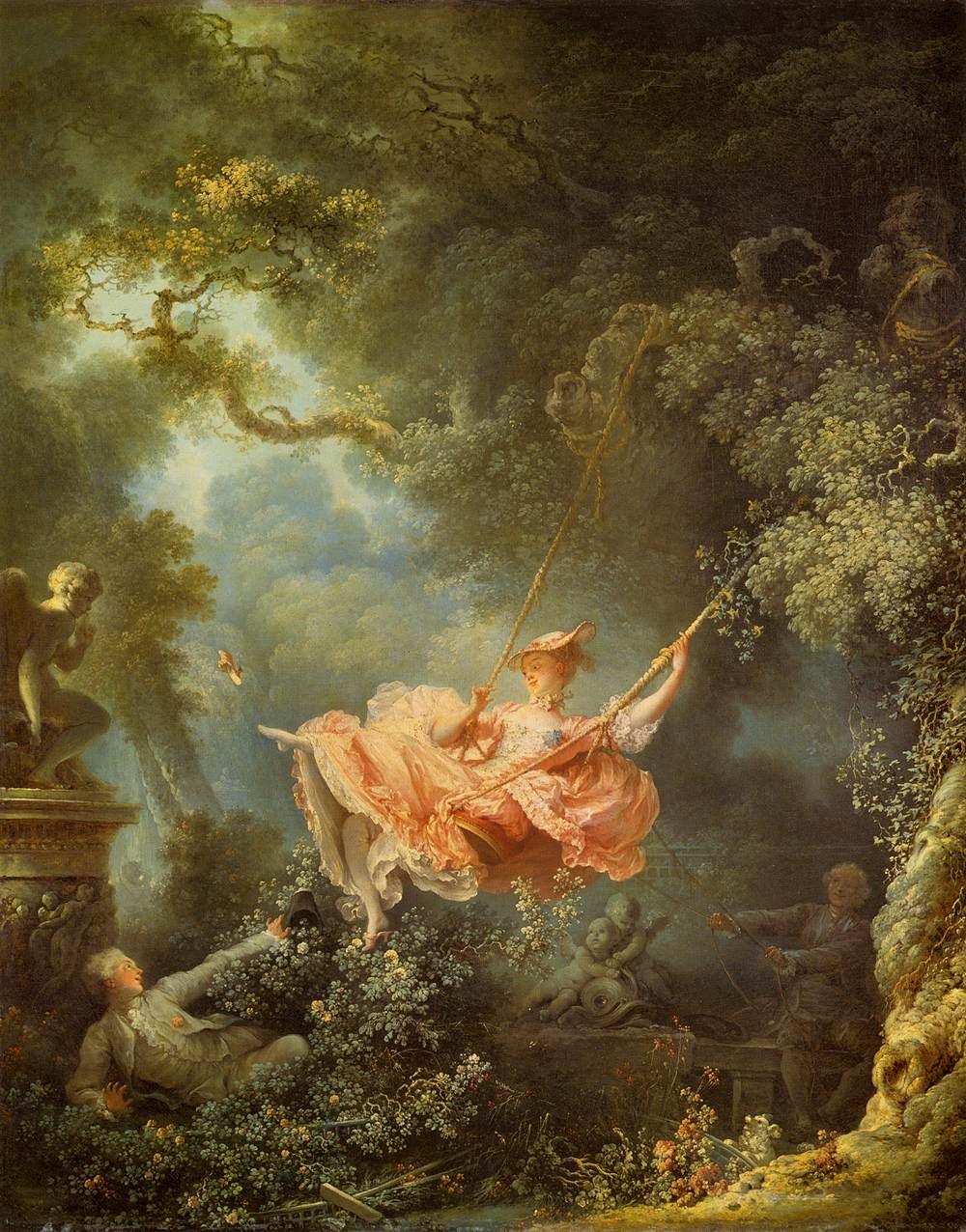
|
Jean-Honoré Fragonard
Les hasards heureux de l'escarpolette (The Swing), 1767
oil on canvas, 81.0 x 64.0 cm
The Wallace Collection, London
|
Melbourne-born Rupert Bunny lived much of his adult life in France. First arriving in Paris in the 1880s, he established a studio on rue Notre Dame des Champs and began exhibiting at the Old Salon in 1888, having his first critical success there two years later when Tritons, c.1890 (Art Gallery of New South Wales) received an honourable mention. Bunny worked hard, but being sociable and outgoing, he also enjoyed a rich social life in the City of Light, frequenting popular meeting places such as the Café de Dôme, attending concerts and the theatre, and counting Sarah Bernhardt (who acquired his work) among his many friends.1 While Bunny maintained strong family connections with Australia and sent paintings home for exhibition, he did not visit again until 1911. He received a warm welcome on this occasion however, being described by the Sydney Morning Herald as ‘perhaps the most eminent painter that Australia has yet produced’2 and mounted successful exhibitions in Melbourne and Sydney from which the National Gallery of Victoria, Art Gallery of New South Wales and Art Gallery of South Australia all acquired works for their collections. During this extended visit, Bunny also undertook numerous portrait commissions of notable figures who recognised his skill and status within the contemporary artistic fraternity. Writing at the time, William Moore, declared that ‘Bunny is an artist with an international reputation, his record being unapproached by any other Australian painter… Two of his best-known pictures were purchased by the French Government for the [Musée du] Luxembourg, which is the highest honour that French Art can bestow on a living artist.’3
The Swing was painted around 1913 and like so many of Bunny’s works, the female figure in the picture was modelled on his wife, Jeanne-Héloise Morel. Also a practising artist, Morel worked in oil, as well as making monotypes and embroideries, and exhibited at the Société des Artistes Français and the Société Nationale des Beaux-Arts. The pair met in 1892 and almost instantly she became Bunny’s favourite model, her ‘ravishing beauty… violet eyes, raven hair, slightly retroussé nose’4 a distinctive and memorable feature of many paintings. Identified as the sitter in portraits such as The Straw Hat, c.1895 (Art Gallery of New South Wales), and Portrait of the Artist’s Wife, c.1896 (National Gallery of Victoria), she also represented a more symbolic and timeless image of femininity and womanhood in paintings including A Summer Morning, c.1908 (Art Gallery of New South Wales), and Who comes?, c.1908 (National Gallery of Australia). The couple married in 1902 and as Bunny scholar, David Thomas, has observed, his depictions of Morel are ‘essays on the ineffable in feminine beauty, they convey love, admiration and an elegance that sets them apart.’5
Pierre–Auguste Renoir The Swing, 1876
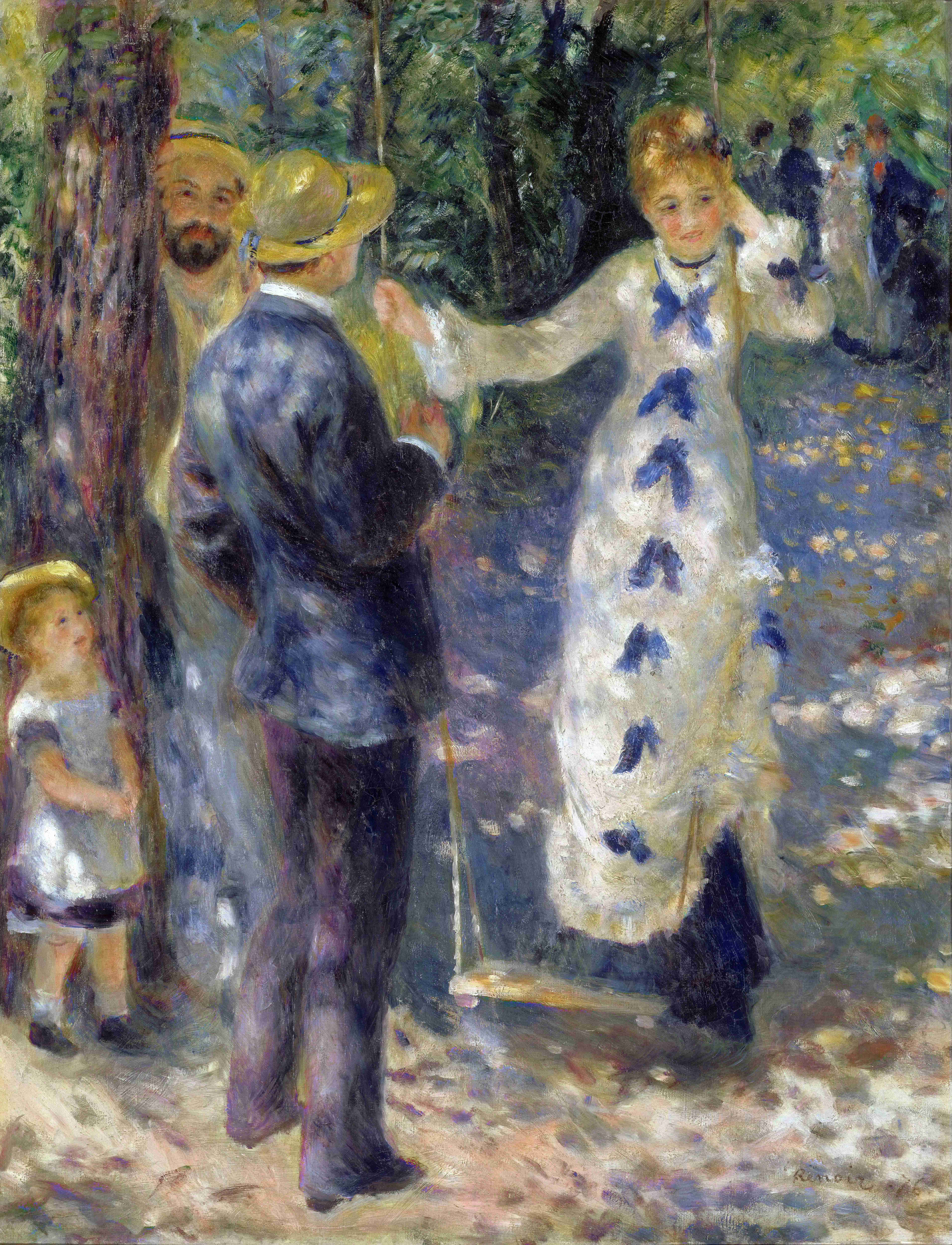
|
Pierre–Auguste Renoir
The Swing, 1876
oil on canvas, 92.0 x 73.0 cm
Musée d’Orsay, Paris
|
Bunny appreciated beauty in all its forms and many of his best-known paintings depict graceful women, either alone or in intimate groups, attired in the elaborate and beautiful fashions of the day. The Swing is no exception and the woman, who is shown seated on an outdoor swing, dreamily looking off into the distance, wears a long sheath-style dress and wrap in shades of apricot with cream and green highlights. What distinguishes this painting from many of Bunny’s images is its focus on a lush garden setting – his attention here is as much on the visual beauty of the natural environment as it is on the stylish elegance of his female subject. A variegated green grassy foreground leads to a view of distant water beyond the figure who is surrounded by flowering bushes and willow branches which frame the upper left corner of the scene. While the subject of a girl on a swing is a familiar theme from historical French art – evoking similar images by artists such as Fragonard, Boucher and Renoir, among others – Bunny’s handling of paint in this work clearly shows the influence of Impressionism. Delicate brushstrokes of colour are laid down on the canvas side by side, carefully building up rich chromatic depth, and there is an emphasis on the representation of the changing qualities of light and shadow which recalls the singular painterly approach of Claude Monet. As David Thomas has written, The Swing is ‘one of the finest examples of Bunny’s impressionistic figure subjects, his interest now focussed on sparkling light and ravishing colour, combined with a technique that is equally vivacious in its handling and breadth. Brushstrokes seem to dance across the canvas with colours of a higher key.’6
1. For more information see ‘Biographical notes’ in Edwards, D., Rupert Bunny, artist in Paris, Art Gallery of New South Wales, Sydney, 2009, pp. 188 – 196
2. Sydney Morning Herald, 19 September 1911, cited in Thomas, D., The Life and Art of Rupert Bunny: A Catalogue Raisonné, vol. 1, Thames & Hudson, Melbourne, 2017, p. 145
3. William Moore, cited in Thomas, ibid., p. 148
4. Thomas, ibid., p. 79
5. ibid.
6. ibid., p. 152
KIRSTY GRANT
